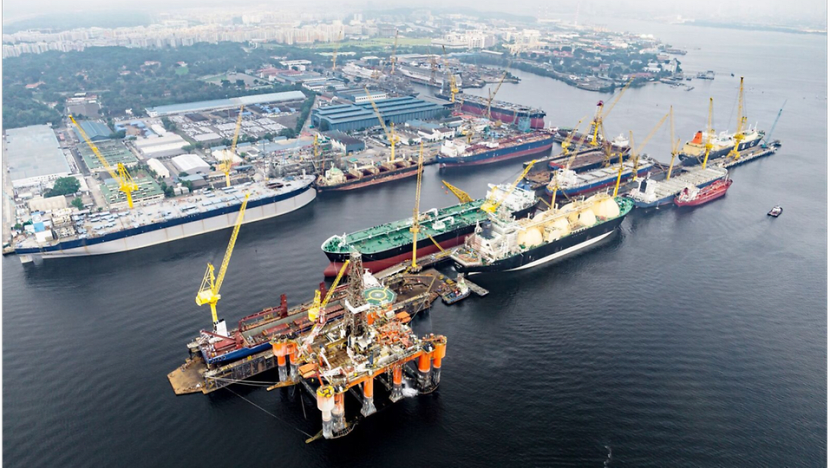A lifeline for Sembcorp Marine
Troubled Sembcorp Marine is getting a reprieve. Money Mind makes sense of the recapitalisation deal for the marine firm.

Aerial view of Sembcorp Marine Admiralty Yard. (Photo: Sembcorp Marine)
SINGAPORE: Sembcorp Marine, the marine arm of conglomerate Sembcorp Industries, has been in the red for the past two years.
Debts have also been piling up, with net debt reaching the S$4 billion mark at the end of last year.
Then COVID-19 and falling oil prices hit.
Oil majors cut their budgets, and new orders began to slow or stopped altogether.
The deal will involve a five-for-one rights issue and a subsequent share distribution that will see Sembcorp Industries and SembMarine parting ways.
Sembcorp Industries will subscribe for up to S$1.5 billion of these rights shares.
Following the rights issue, it intends to distribute its entire stake in SembMarine to shareholders.
Ms Lim Siew Khee, head of Singapore research at CGS-CIMB Research, said this is a good thing for Sembcorp Industries, as it can reposition itself as an integrated energy player.
“They can now focus on urban development and utilities. So hopefully the stock can rerate, and it’s easier to value a company that is focused.”
The rights issue will raise about S$2.1 billion in gross proceeds.
The S$1.5 billion from Sembcorp Industries will go towards repaying a loan that the company extended to SembMarine in 2019.
The remaining S$600 million will either come from SembMarine’s existing shareholders, or from Temasek, who will sub-underwrite the rights issue and buy up any unsold shares.
With the funds, SembMarine’s CEO Wong Weng Sun said the firm will have the financial strength to ride through the prolonged industry downturn and prepare for recovery.
READ: ‘We have to move beyond being oil traders’: What Singapore’s future as an oil hub could look like in a post COVID-19 world
Analysts agree.
“It has lessened the stress on their balance sheet. With the fresh funding, they can then focus on chasing new contracts, without the funding worries,” said Ms Lim
But, in this current weak operating environment, it remains uncertain whether there will even be new contracts to bid for.
According to Paul Chew, head of research at Phillip Securities Research, order books for the yards had already been on the decline even before the pandemic and the collapse in oil prices.
“If you look at FY2020, the oil majors’ capex is expected to drop at least 20 per cent. So the outlook is not just murky. It is pretty dark.”
To remain viable, SembMarine will need to diversify from conventional rigs into other product offerings like renewables and gas solutions.
Mr Royston Tan of the New Academy of Finance said this is not just about being competitive, but also about diversifying the business model into more highly sought-after products, such as vessels for transporting liquefied natural gas.
In the renewables space, SembMarine has been in the offshore wind farm sector since 2015.
It already has offshore wind fabrication jobs in Taiwan and the United Kingdom on its books.
READ: Southeast Asia’s renewable energy transition likely to take hit from COVID-19: Experts
The recapitalisation exercise will leave Temasek with close to a 30 per cent stake in SembMarine at the minimum.
This is because Temasek is the largest shareholder of Sembcorp Industries, and it will get SembMarine shares when Sembcorp distributes its entire stake in the firm to shareholders.
Temasek’s stake could go up to 58 per cent if none of SembMarine’s existing shareholders take up the rights issue.
With all this in mind, what are the options for SembMarine shareholders?
According to Mr Chew, there will still need to be some form of capital raising.
“There will still be a need for SembMarine to raise liquidity, be it the rights, and this would be the best option rather than increase the debt levels even further, as these are already stretched.”
More than 50 per cent or a simple majority of minority shareholders must vote in favour of the proposed rights issue.
A simple majority will also be needed for the whitewash resolution, which waives their rights to receive a mandatory takeover offer from Temasek.
Under Singapore’s takeover code, any entity which has 30 per cent or more of the voting rights of a company will need to make a mandatory offer.
If the deal goes through, existing SembMarine shareholders will see their stakes being significantly diluted from 39 per cent to 6.5 per cent if they do not subscribe for the rights.
But, if they take up the rights offer, they will have to fork out more money just to maintain their stake.
So, it will be a dilemma for these investors.
WATCH: Sembcorp Marine plans to raise S$2.1b through rights issue
Some investors may not even want to make a decision on the rights offer and market watchers caution that they could sell, ahead of SembMarine trading ex-rights.
This is because the share price will have to drop to account for the new rights shares.
The theoretical ex-rights price for SembMarine is 0.29 Singapore cents based on the last 5 day volume weighted average price or VWAP.
The developments around Sembcorp Marine have raised speculation once again of a merger of SembMarine with Keppel’s offshore & marine division.
Last year, Temasek made a S$4.1 billion offer to raise its stake in Keppel Corp to 51 per cent, and the transaction is set to be completed before October this year.
“It makes sense to merge. At the very least, you do not have two yards competing with each other. And secondly, if they don't merge, they also need to reduce their capacity quite drastically," said Mr Chew.
"If you just look at the oil majors’ capex, since 2013, it has halved to the current levels. But if you look at the capacity or the balance sheet of Sembcorp Marine, it has almost doubled from 2013, so you have a bit of a mismatch where the marine capacity has increased. But at the same time the oil majors’ capex has actually shrunk by half," he added.
Mr Tan said such a deal can only materialise if facilitated by the common shareholder of both parties, in this case, Temasek Holdings.
"A merger makes sense in the current context, as it will allow the enlarged entity to pool its resources together, while streamlining its operations to compete more effectively with Korean, Chinese and Japanese yards who themselves are all actively engaging in merger exercises over the past years, to stay relevant,” he said.















